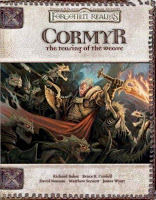One of the things I miss about the earliest days of the TSR adventure modules is the fact that, while they were designed to fit into a particular campaign world (the World of Greyhawk Fantasy Setting), it was also completely possible (and it seems deliberately so) to plug them into one’s own home-brew setting with little or no conversion.
Take, for example, G1-3/D1-3/Q1, the famous “Against the Giants” modules. Although they were set in a particular section of the Flanaess, the basic plot – giants are raiding human settlements and need to be stopped, and some unknown force is the impetus for the raids – can be transferred into just about any campaign world. Modules like S1 “Tomb of Horrors”, while possessing some background information about ancient history and a particularly noteworthy villain of yore, can simply be plunked down into any campaign with a minimum of fuss (bear in mind that the module itself gives several different possible locations for the Tomb; it could be in Iuz, on an island in the Nyr Dyv, in the Bright Desert, in western Geoff, in an island off in the Solnor Ocean, or in the Vast Swamp, which seems to have become the default (and later canonical) locale.
Even modules that seem to be fully integrated with the campaign like T1-4 “Temple of Elemental Evil”, with its complex background of politics, religion, and history, can be placed in just about any campaign with only a small amount of conversion (or no conversion at all, if one fancied putting deities like St. Cuthbert and Iuz into their home campaigns– I know several of my early homebrew efforts had them as gods).
Contrast this with many of the modules that came later, especially the “adventure path” type adventures. Because they were tied to tightly into the background and ongoing story of a particular campaign world, it made it much more difficult to drop them into one’s own homebrew world. Contemplate putting something like DL2 “Dragons of Flame”, or “Cormyr: Tearing of the Weave” into a different campaign milieu. It’s perhaps not impossible, but it does present a much more daunting prospect.
 Note this is not a function of Greyhawk adventures being more quasi-generic; many of the later titles were just as tightly woven into the fabric of the setting as any Dark Sun or Forgotten Realms module could ever aspire to. It’s a function of time, and as far as I can tell the switchover started in the early-mid 1980’s, when homebrew campaigns began to decline in favor of pre-printed settings.
Note this is not a function of Greyhawk adventures being more quasi-generic; many of the later titles were just as tightly woven into the fabric of the setting as any Dark Sun or Forgotten Realms module could ever aspire to. It’s a function of time, and as far as I can tell the switchover started in the early-mid 1980’s, when homebrew campaigns began to decline in favor of pre-printed settings.
This sort of portability is something modern designers might want to bear in mind when designing new adventures. Many OSR titles today are, in some ways, too generic. I think my favorite type is a mix; a module that is set in a particular setting, but which can easily be ported into other campaigns with little effort. That, to me, gives the optimal mix of background texture and portability that makes a module most useful.











Adventure paths are generally less generic (though this varies widely), but they are also not intended to plug into your home-brew setting. A normal module covers a small bit of story, like one book out of a series. Because you'll be transitioning from one story to another they are usually self-contained episodes and as such, can often be fit into many worlds and placed there.
An adventure path is designed as the whole series. They introduce elements like locations and history that are important to the story. This adds a lot to the detail of the adventure path. Imagine Lord of the Rings without all of the details about the history and places. These elements are vital to the storytelling.
The adventure path uses these details to set the scene and give the characters hooks to join into the world. For example, the War of the Burning Sky fron EN World is about a continent-wide war. History, culture and geography are all part of the adventure, and it becomes quite an epic story.
On the other hand, I'm playing in the Skull and Shackles adventure path for Pathfinder. This one has some Pathfinder references, but from what I've seen it could be easily transplanted to any world with piracy and a set of islands off of a continent.
I think TSR made a conscious effort to make generic modules and then have someone on the settings' side of things assign them to an appropriate place in Greyhawk. Later, it seems that modules were designed for a setting and that made them harder to run anywhere else without resolving some conflicts. DragonLance has that reputation. I can't imagine running a Dark Sun module in my Greyhawk campaign as easily as I could something like B1 or B2 in Dark Sun. Yes, the U series wouldn't make too much sense unless that was the one place that had water on the whole planet.